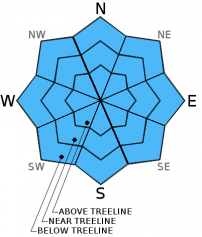| Sunday | Sunday Night | Monday | |
|---|---|---|---|
| Weather: | Partly cloudy skies. | Partly cloudy skies becoming mostly cloudy. | Mostly cloudy skies. |
| Temperatures: | 49 to 54 deg. F. | 30 to 35 deg. F. | 44 to 50 deg. F. |
| Mid Slope Winds: | W | W | SW |
| Wind Speed: | Light winds increasing to 10 to 15 mph. | 10 to 15 mph | 10 to 20 mph with gusts to 30 mph. |
| Expected snowfall: | 0 | 0 | 0 |
| Sunday | Sunday Night | Monday | |
|---|---|---|---|
| Weather: | Partly cloudy skies. | Partly cloudy skies becoming mostly cloudy. | Mostly cloudy skies. |
| Temperatures: | 43 to 48 deg. F. | 29 to 34 deg. F. | 40 to 45 deg. F. |
| Ridge Top Winds: | W | W | W |
| Wind Speed: | Light winds increasing to 15 to 20 mph with gusts to 30 mph in the afternoon. | 15 to 30 mph with gusts to 45 mph. | 15 to 30 mph with gusts to 45 mph. |
| Expected snowfall: | 0 | 0 | 0 |























